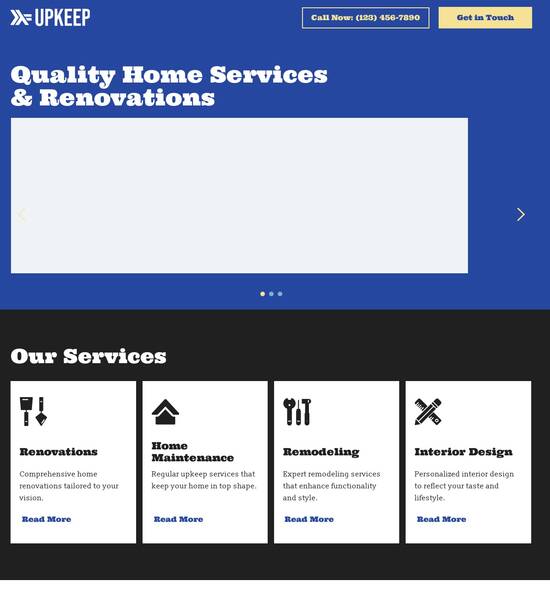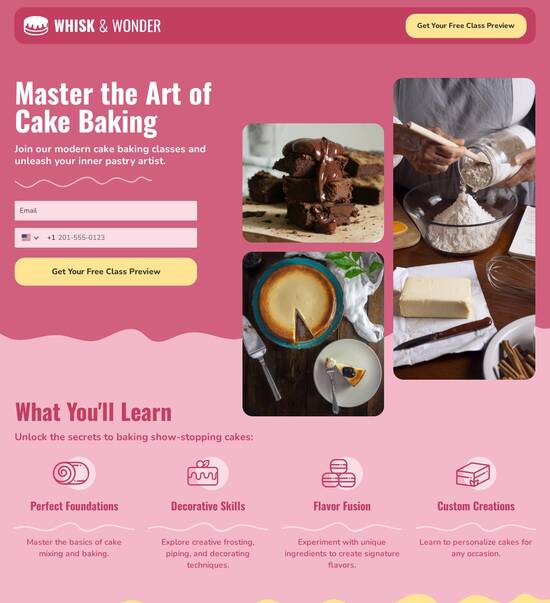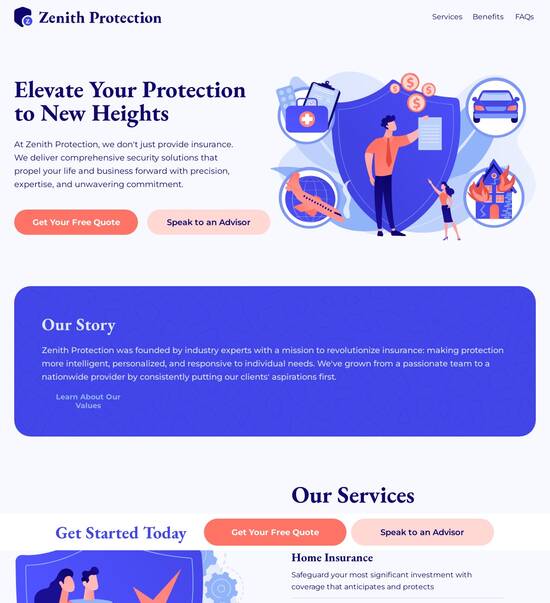
HTML page template with interactive weather bar
Explore Similar TemplatesAbout template
Use HTML page templates with interactive weather bar and make your communications easy and transparent. Try our solution today.
Recommended templates

Easy to build without coding
With the intuitive drag-and-drop builder, anyone on your team can create high-converting pages without any knowledge of code or design. Make enhancements to your landing page with custom widgets using Javascript, HTML/CSS, or third-party scripts.

Multiple layouts for any industry and goal
Select from 500+ landing page layouts built to boost conversions across industry-specific scenarios. Customize them by adjusting fonts, adding images, and generating on-brand content with the AI assistant. Quickly scale with Instablocks® and Global Blocks that you can save, reuse, and update globally.

Loads fast and looks polished on any device
Every template is responsive, which means they present professionally on any device and load blazingly fast with our Thor Render Engine. You can also power them up with Google AMP technology to deliver an unparalleled mobile experience and drive higher conversions.

Robust analytics & experimentation
Get real-time updates and reporting across all your devices, showing the number of visitors, conversions, cost-per-visitor, and cost-per-lead. Launch AI-powered experiments, run A/B tests, and use heatmaps to analyze user behavior, then optimize your landing page to maximize conversions.







Easy to build without coding
With the intuitive drag-and-drop builder, anyone on your team can create high-converting pages without any knowledge of code or design. Make enhancements to your landing page with custom widgets using Javascript, HTML/CSS, or third-party scripts.
Multiple layouts for any industry and goal
Select from 500+ landing page layouts built to boost conversions across industry-specific scenarios. Customize them by adjusting fonts, adding images, and generating on-brand content with the AI assistant. Quickly scale with Instablocks® and Global Blocks that you can save, reuse, and update globally.
Loads fast and looks polished on any device
Every template is responsive, which means they present professionally on any device and load blazingly fast with our Thor Render Engine.
Robust analytics & experimentation
Get real-time updates and reporting across all your devices, showing the number of visitors, conversions, cost-per-visitor, and cost-per-lead. Launch AI-powered experiments, run A/B tests, and use heatmaps to analyze user behavior, then optimize your landing page to maximize conversions.
All the features you need to build lead-generating landing pages
Explore more featuresLearn how to build top-performing landing pages for any goal
FAQs
Leading the way in building high-performing landing pages





Your ultimate step-by-step guide to mastering Instapage for landing page optimization
In the competitive landscape of digital marketing, creating the perfect landing page is crucial for maximizing your ROI. With Instapage, marketers from various sectors including business services, education, and tech can easily build and optimize landing pages that drive results. This guide will provide you with actionable steps to leverage Instapage's powerful features effectively and transform your marketing campaigns.
Understanding the fundamentals of landing pages
Landing pages serve as standalone web pages designed specifically for marketing or advertising campaigns. They direct visitors to take a specific action such as signing up for a newsletter, purchasing a product, or registering for a webinar. Understanding this concept is essential as it lays the groundwork for effectively using Instapage.
- Increased conversion rates: Landing pages focus on a single purpose, leading to higher conversion rates.
- Targeted content: Tailor your message to match user intent, which helps in converting visitors into leads or customers.
- Simplified user experience: Remove distractions to guide visitors toward desired actions.
How to get started with Instapage
Setting up your first landing page on Instapage is straightforward. Here’s a simple overview of the steps you should follow.
- Choose a template: Start by selecting from over 100 high-converting templates tailored to various industries and campaigns.
- Customize your page: Utilize the intuitive drag-and-drop builder to easily add elements like forms, call-to-action buttons, and images.
- Publish and test: Once satisfied with your design, publish your page and conduct A/B tests to fine-tune its effectiveness.
Optimizing for conversions with Instapage
Optimization is key to achieving high conversion rates. With Instapage, you can make informed decisions based on user behavior data.
- Use A/B testing: Test different versions of your landing page to see which performs better, focusing on headlines, images, and calls to action.
- Leverage heatmaps: Detailed heatmaps show how visitors interact with your page, allowing you to make improvements based on actual behavior.
- Dynamic text replacement: Personalize your content by dynamically changing text based on user input, increasing engagement.
By following these steps, you can ensure your landing pages are not just visually appealing but also optimized for maximum performance.
Ready to elevate your digital marketing strategy? Explore the complete suite of tools that Instapage offers to build, optimize, and personalize your campaigns.
Start your free trial today and see the difference in your conversion rates with Instapage.
People also ask about HTML page template with interactive weather bar
HTML page template with interactive weather bar
The evolution of web design templates
HTML page templates have become a fundamental component of modern web development. They serve as the backbone for creating visually appealing and functionally rich websites. Initially, HTML templates were static, consisting of plain markup with minimal interactivity. However, over the years, the integration of CSS and JavaScript has transformed these templates into dynamic storefronts. As web technology matured, templates expanded in complexity and functionality, reflecting the growing demands of users for more engaging online experiences.
With the rise of user-centered design, interactivity has become a critical facet of web templates. Contemporary web browsers now support a broad array of rich media and interactive features that promote user engagement. This shift has led to higher expectations from users, who seek responsive interfaces that provide real-time feedback and personalized content. An example of this modern interactivity can be seen in the increasing popularity of features such as the interactive weather bar.
Understanding the interactive weather bar feature
An interactive weather bar is a dynamic element that displays real-time weather information on web pages. Its main functionality is to provide users with up-to-date weather forecasts and conditions at their location. Key components typically include current temperature, weather icons denoting conditions (like sunny or rainy), and forecasts for the coming days. This feature connects users to relevant information that could influence their daily activities and decision-making.
Integrating a weather bar into HTML templates requires a blend of coding skills and design awareness. Developers can embed the interactive bar as a widget within the existing layout, utilizing APIs to fetch data. Customization options are usually available, allowing developers to tailor the aesthetics and information displayed to align with the website’s branding and user needs.
Diving into user experience enhancement
Enhancing user experience through personalization and relevance is paramount in modern web design. By tailoring content based on geolocation, the interactive weather bar ensures that users receive pertinent information specific to their local conditions. The importance of real-time weather information cannot be overstated, as it aids users in planning their day. For instance, knowing that it will rain later allows users to adjust their plans accordingly, making them more likely to return to your site.
Moreover, multi-device compatibility is crucial for today’s web users, as they access content from various devices. Responsive design considerations are vital when developing an interactive weather bar. It must seamlessly adapt to different screen sizes, providing a consistent experience whether users are on a smartphone, tablet, or desktop. Designing a weather bar that maintains its functionality and appearance across devices is essential to retain user engagement.
Dynamic weather data at users’ fingertips
To deliver accurate and timely weather information, interactive weather bars leverage various APIs from trusted weather services. Popular APIs include OpenWeatherMap, WeatherAPI, and AccuWeather, each offering extensive data on current conditions and forecasts. Reliability is essential; users will quickly lose trust in a site if the weather information provided is inaccurate or outdated.
Typically, users expect to see current temperatures, a short-term forecast, and additional weather conditions displayed prominently. Visual representations such as weather icons, graphs highlighting temperature changes, and color-coded alerts can enhance the user's understanding and engagement. These elements not only improve the aesthetic appeal but also contribute to quick data assimilation, allowing users to make informed decisions at a glance.
Assessing the benefits of interactive weather information
Integrating interactive weather information leads to significantly enhanced user engagement. Studies show that dynamic features can increase the time visitors spend on a site, which correlates with a higher likelihood of conversions. For example, businesses utilizing interactive weather bars have reported improved customer interaction rates. They see more returning visitors who appreciate the real-time weather updates relevant to their location.
The immediacy of weather information influences user behavior, particularly in sectors like travel, fashion, and events. Users may adjust their travel plans based on imminent weather conditions or choose appropriate clothing based on forecasted temperatures. This practical value adds a level of utility that can significantly enhance the viewing experience, encouraging users to view the site as a valuable resource rather than just another web page.
Exploring various conditions and their representations
Various weather conditions such as sunny, rainy, or cloudy affect user perception and engagement with the content on the website. Understanding and effectively conveying these conditions is vital. For instance, a sunny day might inspire vibrant colors and cheerful imagery, while stormy weather might lean towards more subdued tones. The way different weather conditions are represented can impact not only the visual appeal of the site but also the emotions they invoke in users.
Visual adaptations for different weather conditions can also enhance the user interface. Implementing a responsive design that considers weather patterns can help maintain consistent branding while providing relevant visuals. This includes changing color schemes, background images, or even typography to add context to the displayed content. Effective representation goes beyond aesthetics, acting as a bridge connecting users with the experience.
Unpacking the technical aspects of implementation
From a technical standpoint, implementing an interactive weather bar involves a blend of HTML for structure, CSS for styling, and JavaScript for functionality. Frontend development must consider accessibility to ensure all users can access and understand the features provided by the weather bar. This includes using ARIA (Accessible Rich Internet Applications) standards to aid users with disabilities in interacting with dynamic content.
Best practices for performance optimization are key to a smooth user experience. This includes strategies such as caching frequently requested weather data to minimize the load on external APIs and enhance response times. Ensuring that the interactive features load quickly without sacrificing the richness of content will keep users engaged. Employing techniques to streamline data requests and maintain optimal performance will result in a well-functioning and appealing website.
Exploring layouts and design variations
When considering the layout of the interactive weather bar, presenters must evaluate the different styles available. Various template options can be explored, such as horizontal or vertical placements. Each layout has strengths and can be chosen based on the overall design context of the HTML page template. Selecting the best layout is crucial for maximizing visibility and ensuring users can easily see and interact with the weather information.
Also, user interface design principles must be prioritized to provide a clean, user-friendly interface. This includes ensuring that the weather bar does not obstruct or overwhelm other content on the page. An aesthetically pleasing design that balances visual appeal with functionality will resonate more effectively with users, guiding them to find value in the additional weather information presented.
The future of interactive weather bars in web design
Looking ahead, the future of interactive weather bars in web design appears promising. Emerging technologies such as AI and machine learning are set to refine how weather data is collected, presented, and personalized for users. With these advancements, we can expect more localized forecasts, customized alerts for severe weather, and even predictive analytics that suggest actions based on users' historical data and preferences.
Additionally, we may see the integration of social sharing features related to weather conditions, allowing users to connect their experiences with others easily. The continuous evolution of user experience and expectations will drive the need for more sophisticated and adaptable weather bar functionalities in HTML templates, ensuring they remain a relevant asset in web design.
Case studies of successful implementation
Examining real-world examples illustrates the effective use of interactive weather bars. For instance, a local travel agency integrated a weather bar on its homepage, leading to a noticeable spike in inquiries related to outdoor activities. Users expressed appreciation for having access to weather updates as they planned their trips, demonstrating how the feature added real value to the customer experience.
Another case study involves an e-commerce fashion retailer that noticed an increase in conversion rates after incorporating a weather bar. The interactive feature informed users of the weather in their location, thereby helping them choose appropriate outfits. From these examples, key takeaways include the importance of designing user-centered features that enhance engagement while providing real relevance to users. For developers and marketers, effectively utilizing this feature can significantly elevate web experiences.
Ready to skyrocket conversions?
Supercharge your ad campaigns with high-performing landing pages
Get started














